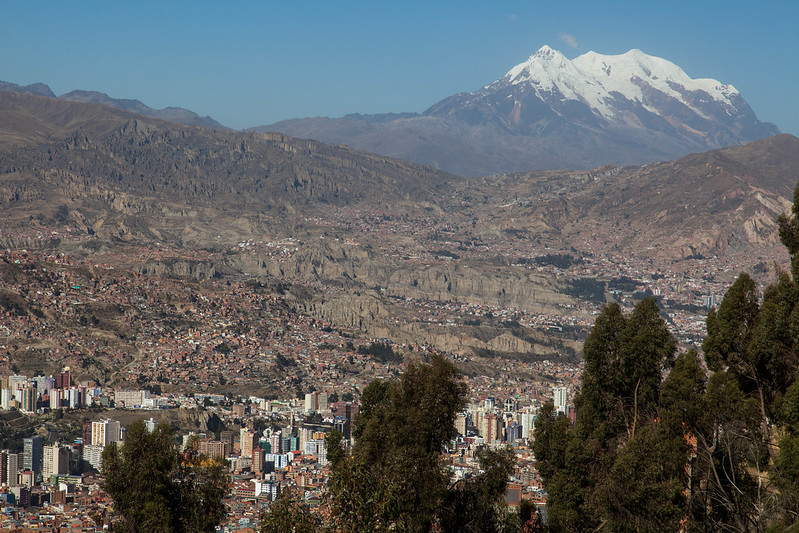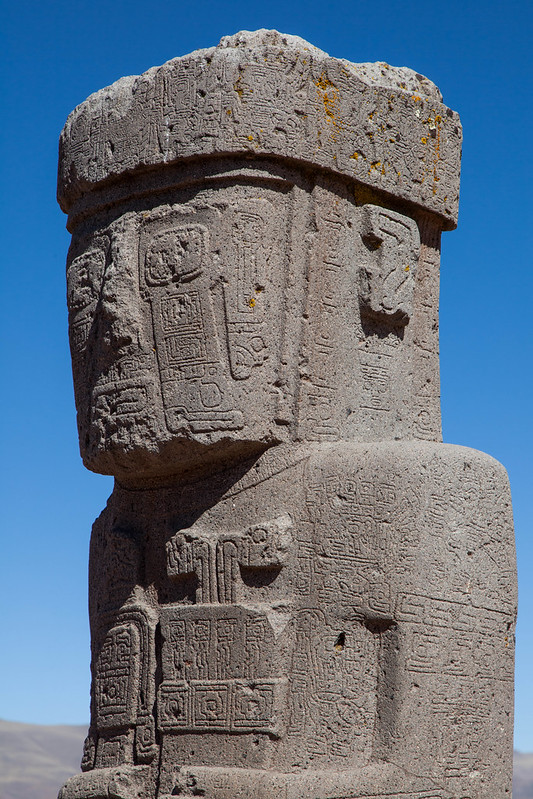 |
| La Paz and the 6000er Illimani in the background |
When we arrived in La Paz we went to a Dutch cafe for breakfast. Why Dutch? No idea. Why are there so many Dutch bars and cafes in Bolivia? Why do all the backpackers hang out in them? Are we looking for Europe in South America? Or we just hoping that we've finally found a cafe where food poisoning isn't included as a free side-dish? Pass. But in general we didn't go for many 'Bolivian' dishes in La Paz. Instead, we ate vegetarian burritos in a Mexican restaurant, saag paneer in an English-Indian curry house, more vegetarian burritos, and finally vegetarian take-away pizza. Someone else was free to hog the Bolivian vegetarian delicacy of fried, grilled or boiled chicken.
But the rest of La Paz looks nothing like England, Italy, Mexico or India. There are a few tourist streets where every shop sells Pachamama (earth mother) jewellery or woolly jumpers, hats, socks, gloves, even full-face masks. I used the loss of my fleece as an excuse to invest in an alpaca jumper and some cosy gloves (although an end to whinging about having cold fingers remains a distant prospect). In the process, I lost my sunglasses and had to nip down to a sunglass stall to see if I could buy them back again. My replacement pair cost £3.50 and were in four different pieces only three days later. Not the best buy of the trip.
 |
| Tiwanaku monolith |
Outside the tourist area, La Paz represents a chaotic world. It's a city built on forty-five degrees, clinging to the sides of a steep river valley with its suburbs topping-out triumphantly on the crest. A substantial proportion of its population are four-wheeled beings - high-emission, clapped-out cars, fuming helplessly in inert lines. We discovered the intensity of the traffic problem on our second morning when we took a bus trip out to the ruins of Tiwanaku. Clearing La Paz took over an hour and involved driving along unpaved side streets and alongside a stream to clear a road block (which makes you wonder how effective the industrial action is?). Alas, the preservation of the Tiwanaku archeological site is little better than the state of the roads. It looks very much like a textbook case of how not to treat a site. Over the years, the original features have been decimated by pillaging. A few structures have been rebuilt; others began to collapse in the process of rebuilding so work stopped; yet others have seen no reconstruction at all. Not a word of signage explains which artefact falls into which category. Interpreting the ruins with no information and inadequate knowledge is certainly a challenge.
Yet we were glad we visited. The Tiwanaku civilisation lasted for almost two thousand years (compared to a few hundred of Inka-dom, so how come they get all the fame?) before collapsing for reasons that remain unclear. Dropping water levels in Lake Titicaca are sometimes held responsible. The Tiwanaku used irrigation intensively to support a high population comparative to the available agricultural land - something that wasn't possible in times of drought. But the artefacts at the site were mostly temples, statues of deities (some defaced with crosses), and the gates of the city's temple complex. Some of the statues at least were well-preserved.
 |
| Tiwanaku masonry |
 |
| The Sun Gate at Tiwanaku |
After a cultured day musing over pre-Incan civilisations, our next day in La Paz could not have been more different. We went biking down 'the most dangerous road in the world' - a dirt track with a precipitous drop on one side, diving into the jungle below. It was once the main road from Coroico to the Altiplano, at which point it may well have deserved its name, but fortunately a new road has replaced it, complete with the extravagances of a metalled surface and safety barriers. The old road has been left to backpackers with mountain bikes and a shortage of braincells - sounds like us?
 |
| Setting off on the death road |
We were driven to a point well above La Paz, just below the snow-line, where we donned as much safety gear as an ice hockey player. We then whizzed down a tarmac-ed road for about an hour. It is possible that I turned the pedals in this time but if you blinked then you missed it. As for gears, what are they for? Mr Gravity was the only person who put any effort into this part of the ride.
At the end of this stretch, our van picked us up and drove us along the next section of road because it climbs for a whole eight kilometres and a backpacker cannot possibly be expected to cycle against a gradient. We both complied but grunted that anyone who cannot cycle the uphill bits should not be allowed on the downhill bits either. No pain no gain, and all that.
Once we were let loose on our bikes again, it was time to hit the 'death road' itself, ready to descend for several thousand metres to Coroico. As it turned out, death didn't feel that close! Yes, the track was rough and the drop precipitous, but the road was wide enough for a motor vehicle (just) so bikers with shaky nerves can easily hug the landward side of the road (as opposed to the BASE jump side). I suspect that whoever named the road hasn't commuted on a bike through central London twice a day for seven years. Bolivia, I see your 'most dangerous road' and I raise you 'Kensington High Street' at 8:15 on Monday mornings. After all, a road cannot be truly dangerous without a fleet of murderous London cabbies playing ten-pin bowling with cyclists' bodies, can it? Having said that, we watched a guy in a group behind us crash. His bike flew off the cliff; his body was half way over before he managed to claw himself back. We so nearly saw someone die. And having saved himself from the precipice, the cyclist's girlfriend nearly killed him instead - his second near-death experience in one day.
 |
| Susan holds bike aloft in a gender-defying move! |
Back to our own experience; we were cycling in a group of four of which I was the only female. This was probably representative of the gender ratio on the road as a whole. No doubt some would make a point about the difference in male and female psychology (acceptance of risk, thrill-seeking, adventurousness, skill-level, awareness of one's own mortality, total bonkers-ness, something else?). I've no idea what the point is, so won't make it. After all, I cycled the death road too. It was also noticeable that in each group the cyclists going quickly at the front were almost exclusively male while the girls were cycling more slowly at the back. Again, conclusions on gender differences are strictly omitted!
The most enjoyable part of the ride wasn't its thrill-seeking aspect though; it was the change in ecosystems. From the start among snow-capped peaks, we descended into lushly vegetated jungle swirling with clouds. We rode under waterfalls, past branches and ferns, with a bird's-eye view of the tropical river valley below. Folds of wooded hillside undulated ahead of us. It was all very National Geographic. And it all unfolded in front of us as we descended towards Coroico without even the need to turn the pedals. This was a day for the muscles around our eyes not the usual biking muscles in the legs. It was also a day for the muscles in our forearms, squeezing the brake pads for dear life, then squeezing them a little harder. Let's not completely forget the precipice at the side of the road after all.
 |
| Riding the death road (without bikes!) |
We arrived in Coroico for a shower, a late lunch, and the opportunity to cosy up with some sand-flies in a hammock. Guy hogged the hammock, ignorant of its existing inhabitants, and got the bites to show for it. He recovered by putting to rights the future of mankind's energy supply, along with a French bloke who worked in a nuclear power station, on the journey back to the city. Fortunately there was plenty of time to crack even this hefty problem, owing to the unyielding La Paz traffic. By the time we arrived it was definitely beer-o-clock. Oh yes, so we did try some Bolivian cuisine after all; Bolivian beer. Even I drank it. After thirty-four years, you could fit all the beer I've drunk in my life into a single pint glass. By the time I leave South America, you'll need a crate. Don't get too excited by this - I maintain that all beer is disgusting stuff - but the up-side is that the brewing process makes the water safe to drink. In some places, that's a price-less quality. So, time for a beer. Actually, make it two beers. I doubt Guy will ever ask me to look after his beer while he goes to the bathroom again!








No comments:
Post a Comment